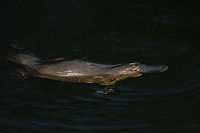Platypus
 From Conservapedia
From Conservapedia | Platypus | |
|---|---|

| |
| Scientific classification | |
| Kingdom Information | |
| Domain | Eukaryota |
| Kingdom | Animalia |
| Subkingdom | Bilateria |
| Branch | Deuterostomia |
| Phylum Information | |
| Phylum | Chordata |
| Sub-phylum | Vertebrata |
| Infraphylum | Gnathostomata |
| Class Information | |
| Superclass | Tetrapoda |
| Class | Mammalia |
| Sub-class | Prototheria |
| Order Information | |
| Order | Monotremata |
| Family Information | |
| Family | Ornithorhynchidae |
| Genus Information | |
| Genus | Ornithorhynchus |
| Species Information | |
| Species | O. anatinus |
| Population statistics | |
| Conservation status | Least concern[1] |
The platypus (Ornithorhynchus anatinus) is an aquatic mammal found in eastern Australia and Tasmania, and one of five species in a distinct subclass named Prototheria, the egg-laying mammals.[2] It has an extremely pliable bill similar in shape to a duck's. Also, like a duck, it has webbed feet. Like all mammals it has fur and suckles its young. The platypus can find its prey in water due to its ability to detect electric fields produced by muscular contractions. The male platypus has a spur on each hind foot which can deliver venom - a feature which very few mammals possess. It has no visible ears.
An excellent swimmer, the platypus spends much of its time guddling for food (mainly aquatic worms, yabby (freshwater crayfish) and any other small creature it can uncover from the walls of its watery world. It swims with an alternating left-to-right paddling of its front feet. Despite all four of its feet being webbed, its hind feet remain held against its body, instead, being used for steering (along with its paddle-shaped tail) rather than propulsion.
The platypus (and its fellow monotreme the echidna) was believed to have evolved in isolation 225 million years ago when the land mass that would become Australia (Gondwana) broke away from the other continents. This idea of evolution in isolation followed the theory of Charles Darwin, whose affinity for evolution may also have been influenced by his early studies of the platypus during his time on HMS Beagle.
However, the isolation theory was overturned when, in the early 1990s, three platypus teeth were discovered in South America - virtually identical to fossil platypus teeth found in Australia. (Marsupials, too, were once considered to be exclusive to Australia, but their fossils have now been found on every continent). Modern adult platypuses do not have teeth, but the discovery of platypus fossils in Australia had already identified that their ancestors did indeed have unique and distinctive teeth.
The platypus is featured on the Australian 20 cent coin.
The strangeness of this animal is sometimes used as evidence that God did have a good sense of humor. The anatomy of the platypus is a problem for evolutionists, because its bill clearly adheres to the same design as that of the duck and its tail to the otter, suggesting a common creator.
Or a similar habitat.
Threats[edit]
The platypus is currently listed as least concern on the IUCN Red List of endangered species;[1] however, the actual number of living individuals in the wild is unknown. The species is dependent on slow-moving streams and shallow-water lakes and ponds, areas which have been disrupted by tropical cyclones over their extreme northern range and by logging in their southern habitats. Man has made inroads into their habitat and altering areas via poor land management, such as excess sedimentation from farm run-off and forestry. Traps meant for fish have also drowned platypus, which has had an adverse affect on small populations of these animals in critical areas.
Apart from man, the chief predator on the Australian Mainland is the introduced red fox (Vulpes vulpes), which scavenges unattended nesting holes for eggs.
Notes[edit]
- ↑ 1.0 1.1 http://www.iucnredlist.org/details/40488/0
- ↑ ↑ The other four are echidnas, also native to Australia.
External links[edit]
Categories: [Mammals] [Monotreme]
↧ Download as ZWI file | Last modified: 02/20/2023 18:14:15 | 12 views
☰ Source: https://www.conservapedia.com/Platypus | License: CC BY-SA 3.0
 ZWI signed:
ZWI signed: KSF
KSF